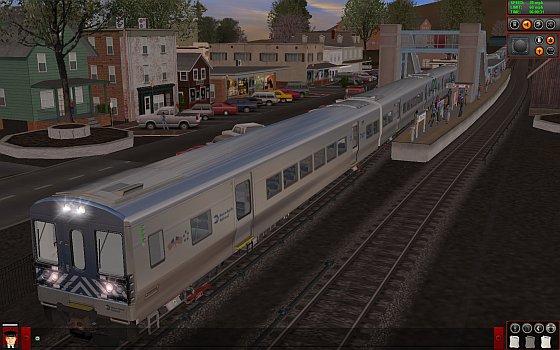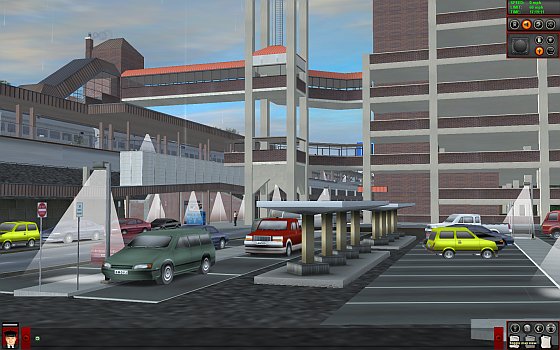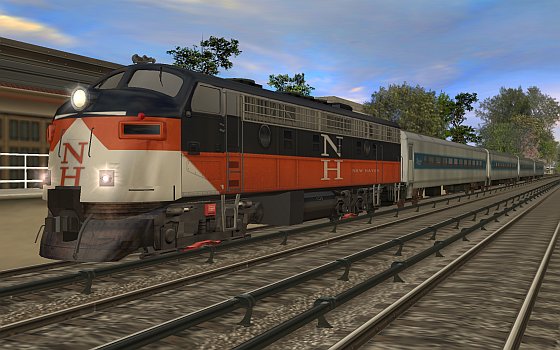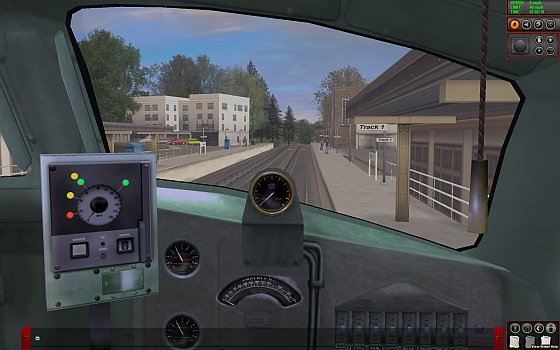|
|
Metro North Harlem Line:
A Trainz Classics Original
By Alfred Barten

A northbound train of Bombardier M7 MU cars (near) gets set to leave Pleasantville. A string of Budd SPV 2000 cars (beyond) heads south.
THROUGH THE YEARS my approach to route design has been to imagine a type of operation and then create a route to go with it. The opposite approach, and one that has found much favor on the MSTS and BVE platforms, is to replicate - or at least be inspired by - the prototype. The new Metro North Harlem Line by Auran is an outstanding example of the latter approach, an authentic modeling of about 38 miles of this busy former New York Central commuter rail line.
Auran took a lot of people by surprise last fall when they announced plans to develop the Harlem Line. Since I've lived along or near the Harlem Line for most of my 67 years, I was intrigued by the selection. Imagine my joy when Auran asked me to help with the research by shooting video from the train along the entire line and then photographing in detail each station and any important buildings along the way. I was joined in this work by my wife, Linda, who proved an invaluable companion as friend and navigator and added pair of eyes in spotting photographic opportunities.

Our visit to Croton Falls was one of the most enjoyable of our many stops. We had lunch at the deli in the single story shop across from the station. A string of the new Bombardier M7 cars is shown on the early morning run to New York City.
Now that I have Auran's finished rendition and have a recent in-depth memory of the route, I can happily say this is the most accurate and complete rendition of any significant prototype route that I'm aware of, though I confess to not having tried everything that's out there.
The choice of modeling a commuter line is also interesting. Having grown up in New York City and surrounding suburbs, transit and commuter modeling is something that strikes me as natural. If nothing else, it provides lots of driver action. The portion of the line modeled by Auran - Bronxville to Southeast - has 20 stations, some closely spaced. All are well-detailed renditions of the originals.
Commuter line modeling is one in which virtual railroading has some natural advantages. For one, trains tend to be long and plentiful. Also, you need long flowing, gentle curves in order to get the right feel; and you would need lots of surrounding infrastructure in the form of buildings. Such modeling in traditional model railroad format is best done with lots of space and lots of expensive small-scale rolling stock and buildings. None of these things are issues when modeling in the virtual format. A single car or building can be duplicated at zero expense, meaning you can have yards full of trains for the cost of a single car and cities full of buildings. In the case of the Harlem Line, there are lots of buildings and prototype rolling stock included in the package.

White Plains was the most complicated station we documented. I took around 80 photos of the station, parking garage at the right and the surrounding structures.
The Prototype Route
The Metro North commuter lines east of the Hudson River begin in New York City at Grand Central Terminal and extend north to the Bronx. This is the Grand Central Division. From there the line splits into three divisions, the Hudson, the Harlem and the New Haven. The Hudson Line veers off to the left at Spuyten Duyvil and continues up the Hudson River to Poughkeepsie. The New Haven Line leaves to the right a little further north at Woodlawn, and continues to New Haven. The Harlem Line continues to Wassaic, NY. The New Haven Line is part of the former New Haven Railroad (NH) whereas the other two lines once belonged to the New York Central Railroad (NYC). All were first combined under the Penn Central merger in 1968, leased from Penn Central by New York City Metropolitan Transportation Authority (MTA) in 1972 and taken over by Metro North under MTA auspices in 1983. MTA has a good online system map.
Electrification. The Grand Central Division uses low voltage DC outside third rail electrification, which continues on the Hudson Line to Croton-on-Hudson, NY. The same electrification continued originally on the Harlem Line to North White Plains, but has since been extended to Southeast (formerly Brewster North) by Metro North. The New Haven Line switches to high voltage overhead AC power at Woodhaven and continues this way to New Haven.
Operations. The mixture of power dating to the Grand Central Terminal electrification in 1906 has given rise to a mixture of locomotive and train types and operations. The New Haven Line was always saddled with operating on low voltage DC on NYC trackage and high voltage AC on its own track. The best-known and still existent locos from the pre-Metro North era are the FL9 diesel electrics originally built by General Motors for the NH and tried on the NYC. The locos appear to be typical GM "bulldog" cab units, but have the unusual wheel arrangements of B+A-1-A, which translates to a lead 4-wheel truck and a trailing 6-wheel truck with the middle axle unpowered. The locos run on diesel power outside New York City's electrified zone and collect low voltage DC from the outside third rail when in the zone. Both forms of power end up driving the unit's DC traction motors.


FL9, outside and in. I took some detail shots of an FL9 while awaiting a run from Wassaic and was asked by a conductor what my interest was. She said the company frowned on photography. Fortunately, I had done my homework and could tell her the Metro North web site specifically says photography is permitted as long as it doesn’t interfere with patrons. I might also have pointed out the age of the FL9 and how many photos of it are already on the web.
The FL9s are now used in push-pull operations, especially in the non-electrified Harlem Line zone (Southeast north to Wassaic), but can be pressed into service for the entire system. The current paint scheme is the old NH orange and black as a nod to rail fans by Metro North. [Continued]
1 | 2 | 3 | Next
Article and screen shots �2007 Alfred Barten. All rights reserved.
More Articles:
[Visit the VR Reading Room.]
If you want to be notified when a new article arrives, join the VR-News group at Yahoo. This group is purely for notification. Anyone can join; only the moderator can post.
|
